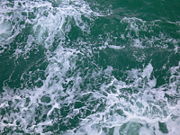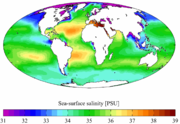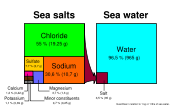Seawater
2008/9 Schools Wikipedia Selection. Related subjects: Geology and geophysics

Seawater is (impure) water from a sea or ocean. On average, seawater in the world's oceans has a salinity of about 3.5%, or 35 parts per thousand. This means that every 1 kg of seawater has approximately 35 grams of dissolved salts (mostly, but not entirely, the ions of sodium chloride: Na+, Cl-). The average density of seawater at the surface of the ocean is 1.025 g/ ml; seawater is denser than fresh water (which reaches a maximum density of 1.000 g/ml at a temperature of 4°C) because of the added weight of the salts and electrostriction. The freezing point of sea water decreases with increasing salinity and is about -2°C (28.4°F) at 35 parts per thousand.
Salinity
| Element | Percent | Element | Percent |
|---|---|---|---|
| Oxygen | 85.84 | Sulfur | 0.091 |
| Hydrogen | 10.82 | Calcium | 0.04 |
| Chlorine | 1.94 | Potassium | 0.04 |
| Sodium | 1.08 | Bromine | 0.0067 |
| Magnesium | 0.1292 | Carbon | 0.0028 |
Although the vast majority of seawater has a salinity of between 3.1% and 3.8%, seawater is not uniformly saline throughout the world. Where mixing occurs with fresh water runoff from river mouths or near melting glaciers, seawater can be substantially less saline. The most saline open sea is the Red Sea, where high rates of evaporation, low precipitation and river inflow, and confined circulation result in the formation of unusually salty seawater. The salinity in isolated bodies of water (for example, the Dead Sea) can be considerably greater.
The density of surface seawater ranges from about 1020 to 1029 kg·m-3, depending on the temperature and salinity. Deep in the ocean, under high pressure, seawater can reach a density of 1050 kg·m-3 or higher. Seawater pH is limited to the range 7.5 to 8.4. The speed of sound in seawater is about 1500 m·s-1, and varies with water temperature and pressure.
Compositional differences from fresh water
Seawater is more enriched in dissolved ions of all types than fresh water. However, the ratios of various solutes differ dramatically. For instance, although seawater is about 2.8 times more enriched with bicarbonate than river water based on molarity, the percentage of bicarbonate in seawater as a ratio of all dissolved ions is far lower than in river water; bicarbonate ions constitute 48% of river water solutes, but only 0.41% of all seawater ions. Differences like these are due to the varying residence times of seawater solutes; sodium and chlorine have very long residence times, while calcium (vital for carbonate formation) tends to precipitate out much more quickly.
Geochemical explanations
| Component | Concentration (mol/kg) |
|---|---|
| H2O | 53.6 |
| Cl- | 0.546 |
| Na+ | 0.469 |
| Mg2+ | 0.0528 |
| SO42- | 0.0282 |
| Ca2+ | 0.0103 |
| K+ | 0.0102 |
| CT | 0.00206 |
| Br- | 0.000844 |
| BT | 0.000416 |
| Sr2+ | 0.000091 |
| F- | 0.000068 |
Scientific theories behind the origins of sea salt started with Sir Edmond Halley in 1715, who proposed that salt and other minerals were carried into the sea by rivers, having been leached out of the ground by rainfall runoff. Upon reaching the ocean, these salts would be retained and concentrated as the process of evaporation (see Hydrologic cycle) removed the water. Halley noted that of the small number of lakes in the world without ocean outlets (such as the Dead Sea and the Caspian Sea, see endorheic basin), most have high salt content. Halley termed this process " continental weathering".
Halley's theory is partly correct. In addition, sodium was leached out of the ocean floor when the oceans first formed. The presence of the other dominant ion of salt, chloride, results from "outgassing" of chloride (as hydrochloric acid) with other gases from Earth's interior via volcanos and hydrothermal vents. The sodium and chloride ions subsequently became the most abundant constituents of sea salt.
Ocean salinity has been stable for billions of years, most likely as a consequence of a chemical/tectonic system which removes as much salt as is deposited; for instance, sodium and chloride sinks include evaporite deposits, pore water burial, and reactions with seafloor basalts. Since the ocean's formation, sodium is no longer leached out of the ocean floor, but instead is captured in sedimentary layers covering the bed of the ocean. One theory is that plate tectonics result in salt being forced under the continental land masses, where it is again slowly leached to the surface.
Human consumption of seawater
Accidentally consuming small quantities of clean seawater is not harmful, especially if the seawater is consumed along with a larger quantity of fresh water. However, consuming seawater to maintain hydration is counterproductive; in the long run, more water must be expended to eliminate the seawater's salt (through excretion in urine) than the amount of water that is gained from drinking the seawater itself.
This occurs because the amount of sodium chloride in human blood is actively regulated within a very narrow range of 9 g/L (0.9% by weight) by the kidney. Drinking seawater (which contains about 3.5% ions of dissolved sodium chloride) temporarily increases the concentration of sodium chloride in the blood. This in turn promotes sodium excretion by the kidney, but the sodium concentration of seawater is above the maximum concentrating ability of the human kidney. Eventually with further seawater intake the blood concentration of sodium will rise to toxic levels, removing water from all cells and interfering with nerve conduction ultimately giving seizures and heart arrhythmias which become fatal.
Of note, various animals adapt to harsh living conditions. For example, the desert rat is able to concentrate sodium far more efficiently than the human kidney, and therefore would be able to survive by drinking seawater.
Survival manuals consistently advise against drinking seawater. For example, the book "Medical Aspects of Harsh Environments" (Chapter 29 - Shipboard Medicine) presents a summary of 163 life raft voyages. The risk of death was 39% for those who drank seawater, compared to only 3% for those who did not drink seawater. The effect of seawater intake has also been studied in laboratory setting in rats. (Etzion and Yagil; Metabolic effects in rats drinking increasing concentrations of sea-water. Comp Biochem Physiol A. 1987;86(1):49-55.) . This study confirmed the negative effects of drinking seawater when dehydrated.
The temptation to drink seawater has always been greatest for sailors who have expended their supply of fresh water, and are unable to capture enough rainwater for drinking. This frustration is described famously by a line from Samuel Taylor Coleridge's The Rime of the Ancient Mariner:
- "Water, water, every where,
- Nor any drop to drink."
Although it is clear that a human cannot survive on seawater alone, some people claim that one can drink up to two cups a day, mixed with fresh water in a 2:3 ratio, without ill effect. The French physician Alain Bombard claimed to have survived an ocean crossing in a small raft using only seawater and other provisions harvested from the ocean, but the veracity of his findings was challenged. In Kon-Tiki, Thor Heyerdahl reported drinking seawater mixed with fresh in a 40/60% ratio. A few years later another adventurer named William Willis claimed to have drunk two cups of seawater and one cup of fresh per day for 70 days without ill effect when he lost his water supply.
Most modern ocean-going vessels create drinkable (potable) water from seawater using desalination processess such as vacuum evaporators, flash evaporators, or by the use of reverse osmosis. However these processes are energy intensive, and most were not available or practical during the age of sail.

